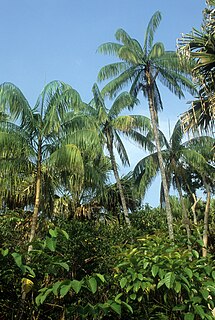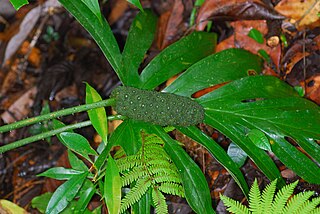Paracroton is a genus of flowering plants in the Euphorbiaceae first described as a genus in 1859. It is native to South and Southeast Asia, as well as New Guinea.
- Paracroton integrifolius(Airy Shaw) N.P.Balakr. & Chakr. - Kerala, Tamil Nadu
- Paracroton pendulus(Hassk.) Miq. - India, Sri Lanka, Myanmar, Thailand, Malaysia, Borneo, Sumatra, Philippines
- Paracroton sterrhopodus(Airy Shaw) Radcl.-Sm. & Govaerts - W New Guinea
- Paracroton zeylanicus(Müll.Arg.) N.P.Balakr. & Chakr. - Sri Lanka

Agrostistachys is a plant genus of the family Euphorbiaceae first described as a genus in 1850. It is native to Southeast Asia, New Guinea, India, and Sri Lanka.
- Agrostistachys borneensisBecc. - India, Sri Lanka, Thailand, Vietnam, Malaysia, Borneo, Philippines, Sumatra, New Guinea
- Agrostistachys gaudichaudiiMüll.Arg. - Thailand, Peninsular Malaysia
- Agrostistachys hookeri(Thwaites) Benth. & Hook.f. - Sri Lanka
- Agrostistachys indicaDalzell - India, Sri Lanka, Thailand, Vietnam, Myanmar, Laos, Cambodia, Malaysia, Borneo, Philippines, New Guinea
- Agrostistachys sessilifolia(Kurz) Pax & K.Hoffm. - Peninsular Malaysia, Borneo, Sumatra
- Agrostistachys staminodiataSevilla - Sumatra

Dimorphocalyx is a genus of plants under the family Euphorbiaceae first described as a genus in 1861. It is native to Southeast Asia, Hainan, India, Sri Lanka, New Guinea, and Queensland.

Aporosa is a genus of flowering plant belonging to the family Phyllanthaceae, first described as a genus in 1825. It is native to China, the Indian Subcontinent, Southeast Asia, Papuasia, and Queensland.

Cleistanthus is a plant genus of the family Phyllanthaceae, tribe Bridelieae, first described as a genus in 1848. It is widespread in much of the Old World Tropics in Asia, Africa, Australia, and various oceanic islands. Cleistanthus collinus is known for being toxic and may be the agent of homicides or suicides.

Hanguana is a genus of flowering plants with a dozen known species. It is the only genus in the family Hanguanaceae.

Daphniphyllum is the sole genus in the flowering plant family Daphniphyllaceae and was described as a genus in 1826. The genus includes evergreen shrubs and trees mainly native to east and southeast Asia, but also found in the Indian Subcontinent and New Guinea.

Pothos is a genus of flowering plants in the family Araceae. It is native to China, the Indian Subcontinent, Australia, New Guinea, Southeast Asia, and various islands of the Pacific and Indian Oceans.

Oncosperma is a genus of flowering plant in the family Arecaceae. It contains the following species, native to Southeast Asia and Sri Lanka:

Isonandra is a genus of plants in the family Sapotaceae found in tropical Asia, described as a genus in 1840.

Lasia is a genus of flowering plants in the family Araceae, native to Asia and New Guinea. The genus contains only two known species, Lasia spinosa and Lasia concinna. Lasia was believed to be a monotypic genus until 1997 when a wild population of Lasia concinna was discovered in a farmer's paddy field in West Kalimantan, Indonesia. The farmer had been growing them for their edible young leaves. This species of Lasia had been known of previously only from a single specimen at the Bogor Botanic Gardens, formally described in 1920. Prior to 1997, the specimen was believed to have been a hybrid between Lasia spinosa and Cyrtosperma merkusii. The subsequent discovery by Hambali and Sizemore led to the realization that it was in fact a distinct species.

Benkara is a genus of flowering plants in the family Rubiaceae. It is found in tropical and subtropical Asia from India east to China and the Ryukyu Islands, south to Java and the Philippines. It was described by Michel Adanson in 1763.
Hydrophylax is a monotypic genus of flowering plants in the family Rubiaceae. It was described by Carl Linnaeus the Younger in 1782. The genus contains only one species, Hydrophylax maritima, which is found in India, Sri Lanka and Thailand.

Catunaregam is a genus of flowering plants in the family Rubiaceae, native to tropical Africa and tropical Southeast Asia.
Bungarimba is a genus of flowering plants in the family Rubiaceae. The type species was transferred from Porterandia by K.M. Wong in 2004. The genus is found from Borneo, Malaysia, Sumatra and New Guinea.
Cyanoneuron is a genus of flowering plants in the family Rubiaceae. The genus is found on Borneo and Sulawesi.
Diyaminauclea is a monotypic genus of flowering plants in the family Rubiaceae. The genus contains only one species, viz. Diyaminauclea zeylanica, which is endemic to Sri Lanka.

Neurocalyx is a plant genus in the coffee family Rubiaceae. Species are found in southern India and Sri Lanka.
Steenisia is a genus of flowering plants in the family Rubiaceae. The genus is endemic to the island of Borneo.
Fergusonia is a monotypic genus of flowering plants in the family Rubiaceae. The genus contains only one species, viz. Fergusonia zeylanica, which is only found in southern India and western Sri Lanka.












